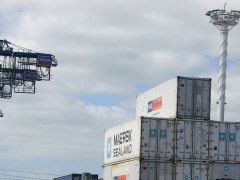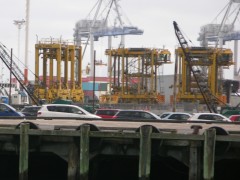Auckland Port Prepares For Huge Ships
Auckland Ports is preparing for the arrival of much bigger container vessels.
It annnounced today a multi-million dollar investment in a berth deepening and lengthening programme.
The investment will see the deepening of the northern berth at the Port’s Fergusson Container Terminal, and the construction of a mooring “dolphin” that will extend the maximum combined length of vessels able to be serviced simultaneously at the terminal by approximately 40 metres.
Ports of Auckland’s Chief Executive Jens Madsen said today it was clear that more vessels in the 3500-5500 TEU (twenty-foot equivalent unit) range will be introduced into New Zealand services over the coming years.
“This trend will result in the requirement for major ports to be able to accommodate two such vessels simultaneously. This need is now more pressing than the need to accommodate the arrival of single larger vessels of 6000TEU and above.”
Mr Madsen said this investment will ensure sufficient depth along the full length of the Fergusson terminal to reliably accommodate vessels as draughts deepen.
The maximum vessel draught at chart datum (the lowest of low tides) on the outer berth will be increased from 11.7m to13.0m. This will be in addition to the current maximum vessel draught at chart datum for the inner berth of 12.5m.
The ‘dolphin’ construction – a mooring structure separate from the main wharf - will ensure vessels can be safely moored on the outer berth with a greater overhang than the current scenario.
Mr Madsen said that the idea of 7,000 TEU sized vessels regularly visiting New Zealand by 2015, a timeframe suggested in a recent report from the Shippers Council, seemed optimistic, which is why Ports of Auckland was taking a step-by-step approach.
“A number of stakeholders in the supply chain, including shipping lines, think it would be reasonable to expect ships of around 5,000-5,500 TEU calling on a regular liner service within the next five years. That is the immediate scenario we are planning for.
“We think it is a prudent approach, and one that will sustain and enhance Ports of Auckland’s reputation as New Zealand’s leading container port,” Mr Madsen said.
Ports of Auckland is New Zealand’s largest container port, holding 63% market share of the upper North Island container trade.
The berth deepening, which already has consents in place, will begin in the first quarter of 2011, followed by the construction of the ‘dolphin’, with works scheduled for completion by the end of 2011.













15 Comments
I never understood why anyone would want to move the ports to Whangarei or Tauranga.
Having a working port in town is not only an important economic factor, it’s also pretty cool. I like most of the recent waterfront initiatives, but real industrial/transport activity is also needed to “keep it real”, or it will not be the same.
The main issue is not so much containers. The really annoying thing is seeing newly imported cars and trucks parked up 200m from Britomart.
I dont think this happens in any any civilised city around the world.
The question we need to ask is should Auckland be the countries premier port or is the expected future growth better handled at Tauranga/Whangarei in the long term.
@Luke Agree. Have included a photo of it. What a wasted waterfront opportunity.
“I dont think this happens in any any civilised city around the world.”
If you go around the world, you’d find lots of cases where cargo, of whatever size, is unloaded and handled in areas directly near the CBD waterfront.
“Should Auckland be the countries premier port”
Short answer: Yes. Except for some bulk exports, Auckland is the most important (because most densely populated and most strongly growing) location for in- and outbound freight, so it makes no sense to move the port to a less economic, more transport-intensive location just because some people dislike port activities (for most of the waterfront areas now being discussed, the port was there first in any case).
Over the next 5-10 years, we will also be transforming several kilometers of the western waterfront (Wynyard Quarter) into a more publicly accessible space, including Queen’s Wharf. I do not see why we should throw POAL out of the eastern part as well. Without their economic input, we’d be poorer off several ways (and further, Wellington would rule us even more strongly if we didn’t have that important economic asset in Council control).
I’m not arguing we should ‘throw POAL out’.
Just dont think the amount of containers going through POAL should increase hugely. Currently Port of Tauranga take a couple of hundred thousand containers from Aucklands backyard and rail them to the port there. They can obviously do this economically so cant see there is a major disbenefit of moving more elsewhere.
Much of the exports going out actually come from Waikato and the hinterland, therefore just as easy to send from Tauranga as Auckland so no problem there.
POAL should grow in Auckland and be NZ’s main port. It has the ability to further expand east. Auckland itself absorbs a lot of the imported goods, so landing them there is a bonus.
“Just dont think the amount of containers going through POAL should increase hugely. ”
Well, there is that little fact of Auckland growing by one million inhabitants in the next 30-40 years, so the amont WILL continue to grow significantly.
Speeding up the unloading and shipping process (especially improving container rail access) would do a lot to keep the negative impacts to a minimum.
Dan, POAL should only be allowed to expand if it doesn’t involve taking land that’s currently public. They’ve monopolised public spaces for too long as it is, without giving them more recreational area on top.
“They’ve monopolised public spaces for too long as it is, ”
Tell me ONE public space they have monopolised? You seem to have this totally backwards. The spaces they are on, they have reclaimed themselves from the Waitemata, or were reclaimed earlier by their predecessor, the Auckland Harbour Board. They were never public spaces in the “parks and boulevards” sense.
The fact that some of them are now BECOMING public like Wynyard Quarter and Queen’s Wharf is actually something we should be thankful for - there wouldn’t be much space down there at all if we were stuck with the old shoreline (see below):
http://en.wikipedia.org/wiki/File:Auckland_Waterfront_Plan.jpg
Karl, Queens Wharf etc used to be open to the public. They may not have been a park in the ordinary sense, but the public could walk through the area. That’s what I mean by monopolised.
Matt, Queen’s Wharf IS open to the public again - you can go out there now, on your lunch break today.
As for the remainder of the ports being closed to casual walk-ins: Well, it’s obvious that three-story high straddle carrier trucks and customs exclusion zones don’t mix well with lost tourists and curious walkabouts. That’s just safety, not “monopolising” something out of any bad attitude.
You want this kind of environment to be a bit more controlled:
http://commons.wikimedia.org/wiki/File:K_Crane_Visit_ZPMC_In_Ports_of_Auckland_IX.jpg
And in any case, the areas are still reclaimed land (or piers) created for the specific purpose of ports operations, not public access, so again, I do not understand the comments about the ports doing something wrong by being there.
an important point in Tauranga’s favour is this public waterfront land problem is not an issue for them. I don’t think it matters so much where stuff arrives/departs. Isn’t that what land transport is for, and arguably access to southern warehouses in Auckland is often less problematic coming/going from the south than across the isthmus.
“is this public waterfront land problem is not an issue for them”
Um, you ARE aware that Ports of Tauranga occupies a massive strip of land right along Mount Manganui, the most famous part of Tauranga?
Probably not, but a quick check on Google Earth will show you. I imagine those areas are very much a bone of contention for people there too, who feel that ports should get out of “prime land”. So the problem exists there just as much as in Auckland.
“I don’t think it matters so much where stuff arrives/departs. Isn’t that what land transport is for,”
The trucking lobby loves that kind of attitude - get all the stuff in containers, ship is PAST Auckland on the high seas (because most freight comes from Australia, Asia or Europe anyway), and then truck it all the way back up into Auckland, over 200km in extra distance, dozens to hundreds of extra trucks a day. If they can’t swing a couple new state highway upgrades and motorway projects that way, they aren’t trying ;- )
@ Karl a few points to correct you on there.
The container port is on the Tauranga side of the port, NOT at the mount.
Already at the moment there are a couple of thousand containers/year that are landed at Tauranga and railed to Auckland, NOt trucked. The capital cost of expanding POAL could easily be beaten by the extra cost of transporting by rail to Tauranga needed.
“The container port is on the Tauranga side of the port, NOT at the mount.”
Luke, it’s pretty unimportant WHICH part of Ports of tauranga is on the Mount side. Fact is they have LOTS of area on that side. As I said, google aerial will show you. Or look at this photo looking down from the Mount
http://en.wikipedia.org/wiki/File:Cruise_Ship_In_Port_Of_Tauranga.jpg
In Auckland, it isn’t primarily the container port area under discussion either, it’s the old bulk liquids areas (Wynyard Quarter), and Queen’s Wharf and nearby areas, which handle (handled) vehicles and similar. So in summary, the problem very much applies in Tauranga too. City growth and port growth conflict in both cities.
“Already at the moment there are a couple of thousand containers/year that are landed at Tauranga and railed to Auckland, NOt trucked. The capital cost of expanding POAL could easily be beaten by the extra cost of transporting by rail to Tauranga needed.”
Do you have any comparison with how many are already being TRUCKED, though? And where do you think the growth will occur in the next couple of years, what with the current government closing rail lines and treating trucking companies like they are virtuous charitable organisations in need of some government assistance?
Also, why should we (Auckland) give Tauranga that growth? Especially as it is a Council business? Investment is a business decision too - if POAL sees opportunities for business growth, saying “You go and have it” to Ports of Tauranga would be stupid . Might just as well expect Coca Cola to say to Pepsi “You go and increase your market share at our expense”.
There’s lots of space for further reclamation around Mechanics Bay, west of the Parnell baths, and maybe some slight bit more space for expanding more northwards into the Waitemata. That should cover the needs for the next 20-30 years. Shifting such crucial infrastructure out of our city meanwhile - Auckland loses out if such a decision is made.